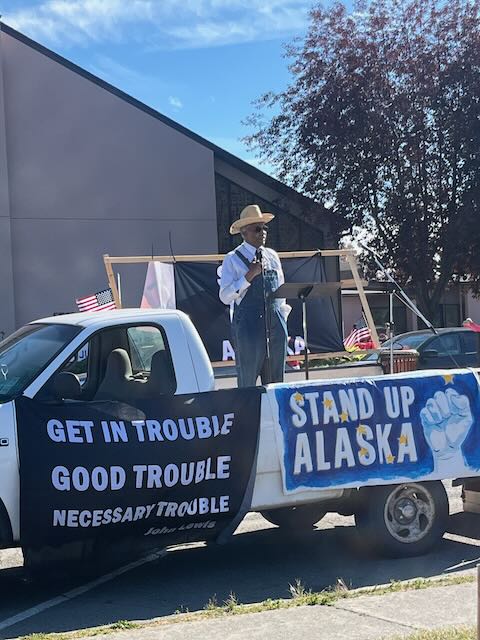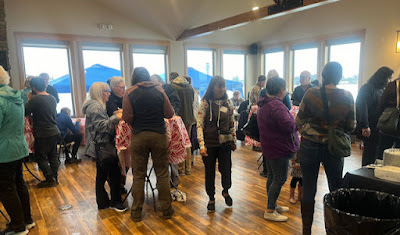RAIS (Refugee Assistance and Immigration Services) is among the groups that help folks under the umbrella of Catholic Social Services in Anchorage, (I'd also say I've never seen a trace of proselytizing in any of the RAIS activities.)
Yesterday, Thursday, June 26, was the first day of their summer CSA program pick up. That's Community Supported Agriculture - a program where consumers pay farmers upfront and then pick up fresh vegetables every week. In Alaska, that is necessarily limited to summer.
I first learned and blogged the term CSA in March 2009 when I was a volunteer with an NGO (non-governmental organization, what we call non-profit) in Chiangmai, Thailand. Here's that post which talks about CSAs in general and what was happening in Chiangmai specifically.
Because it was the first day of Grow North Farm's 2025 CSA distribution there was also a celebration for World Refugee day. with music, dancing, art activities, and food from around the world. (That sentence was more or less lifted and edited from the email I got from RAIS.
For the rest of the summer, in addition to the subscribers picking up their veggies, there will be booths where other refugee farmers will be selling their crops. Here's a blog post from 2022 showing you the variety of things for sale. It's always colorful and people are often wearing the clothing they would wear in their original countries. There are also people selling baked goods. The one that captured me last summer - the Egyptian Kitchen - won't be here this summer. They are in Egypt until fall. Lots of folks will miss their incredible home made cookies.
Yesterday, I only saw a couple of tents where people were selling veggies and preserved food. Most of the booths were services available in Anchorage. The library was there - my mind's going blank - and there were a number of groups with various arts and crafts activities for kids.
I spent more time at the
Choosing Our Roots table, because it was a group I knew nothing about. This is Adam in the photo. He's head of the Board of Directors. Later, the Executive Director Chami joined us. Basically this groups helps queer youth find housing and get their feet on the ground. They work with various groups including Alaska Housing, Alaska Children's Trust, Covenant House, and RAIS.
'Youth' means about 15 to 25. Chami said she herself had been homeless with a baby and worked herself out of that situation and is now a social worker (I'm pretty sure that's what she said) and a licensed therapist (I'm sure she said that). So she can counsel these youth with first hand experience of what they are going through.
This was a very colorful (in the literal sense of that word) event and a photographer's buffet. Except it wasn't. Many of the people, for cultural reasons, do not want to be photographed.
And as the title hints, two different people I mentioned this event to responded, "So ICE will be there?"
So no, I don't want to give ICE any assistance in identifying potential targets.
I took only a few pictures. Of course I should have taken pictures of the vegetables, but I wasn't thinking. We got, as our CSA email listed:
• Radish
• Spinach
• Sorrel
• Bok Choi
• Either Chamsur or Arugula
Don't know what Chamsur is? Well, the RAIS email tells us not only what it is, but also how to use it.
"Chamsur is the Nepalese word for Garden Cress - a green which is popular in mountainous regions of Nepal and Afghanistan. Nepalese farmers brought seeds to Fresh International Gardens to experiment with growing Chamsur in Alaska - it proved to be well suited to Anchorage and has grown at the farm every year since!
Include garden cress in any soup, salad, or sandwich for a tangy flavor. The taste is very similar to that of arugula, so it works great in any wraps, sandwiches, or salads! Add this
Green Salad with Garden Cress to your list of tasty summer salads! Or use both your spinach and chamsur in this
Chamsur Palungo recipe."
Don't know what to do with sorrel? Another hint from the email:
"Sorrel is another tangy green, bright and lemony and makes a lovely Ukrainian Sorrel Soup - perfect for a rainy summer day."
I did take a few pictures and I've smudged out the faces of kids and people who might not want ICE to know they were there.
And if ICE was there, they were unmasked and unarmed and just chilling with everyone else. Here are a couple of pictures.
I'm trying folks. I've got pieces of about five posts that haven't been posted. So many other things are luring me from the blog.
I'm trying to decide if I really want to duplicate last summer's 1000 miles (1600+ kilometers) of biking. I'm at 740k so far. (That's slightly ahead of last summer. But there were bike-able days in March this year, and last year I was biking hard the second half of the summer.)
I'm doing Duolingo Turkish everyday. Sometimes I feel like it's hopeless because it's focused on everything but my speaking. And while I'm gathering vocabulary and a loose understanding of the grammar (and all the fascinating but maddening suffixes which change tense, change who is acting, indicate coming and going, and many other conditions), I don't think I can actually use it to make oral conversation. Speaking uses other muscles and parts of the brain than reading, writing, and even listening. But Turkey is the last place on my list of places I promised myself I'd go to another time. I passed it up while I was a student in Germany and decided more time in Greece for then, and Istanbul later. Later is going to be never if I don't do it soon.
And now I'm taking letters every Monday afternoon to my two Senators and my member of Congress. I'm trying to find different ways to try to break through to them. But I do believe that numbers matter to legislators, so I encourage others in Anchorage to join the group. Just go to their offices (510 L Street for the Senators, 6th and 7th floors, and half a block away (1016 W Sixth Ave Suite #406) between 4pm and 5pm on Mondays. There's no formal gathering, just people coming and going. And if you miss a week or two, not a problem. But I am getting to know the staff. Begich has a second office in Fairbanks. And Murkowski and Sullivan offices in Fairbanks, Juneau, Ketchikan, Matsu, Soldotna. So you folks can also make weekly drop-offs.
Biking gives me a chance to see what's new and changing in Anchorage, so I have pics on some of those things to put up.
I did post about the closing of Lake Otis at 42nd. Lake Otis is back working, but work on 42nd continues.
There's somebody working on an ordinance to change local Anchorage elections to ranked choice voting (the State has that, though Republicans are trying again to do away with it) and I'm trying to get more info on who is doing this and how it's going. I know an Assembly committee had it on their agenda this week. This would be a great improvement.
Gardening and regularly visiting the Alaska Botanical Garden as part of one of my bike routes.
Don't despair. Find beauty every day. Get outside and move your body. (The biking and gardening) Find good folks to be around. Find ways to resist.
There are organizations offering lists of ways to fight back daily. Taking action is the best antidote for hopelessness. Here are two that send me regular (not daily) emails with list of ways I can resist:





 There was a long line at the WIC table. This market is in the lowest income area of Anchorage and the
There was a long line at the WIC table. This market is in the lowest income area of Anchorage and the 


















































